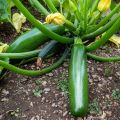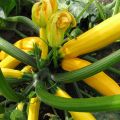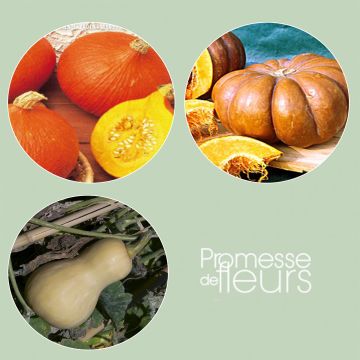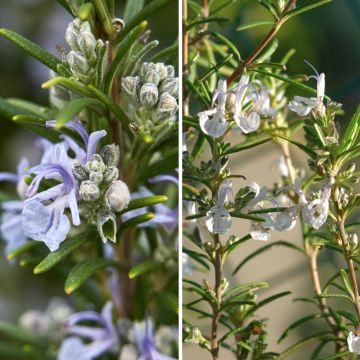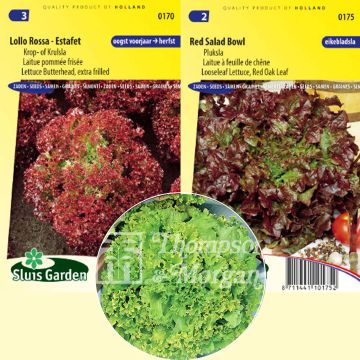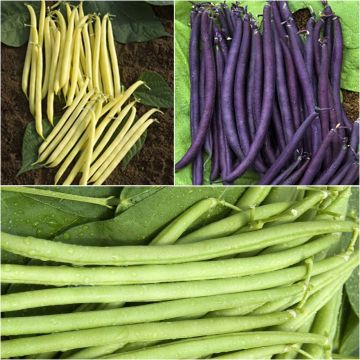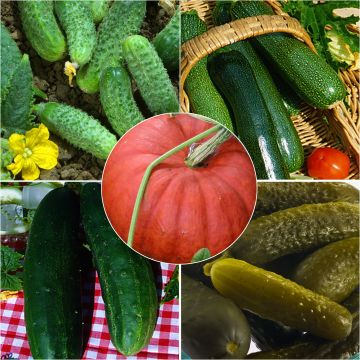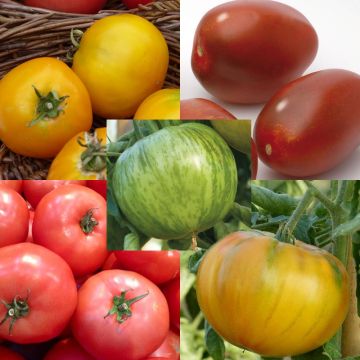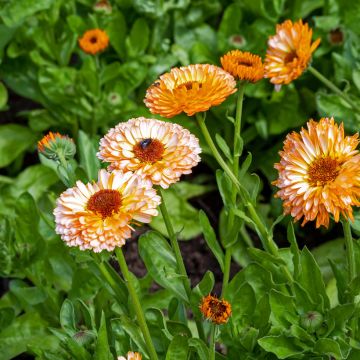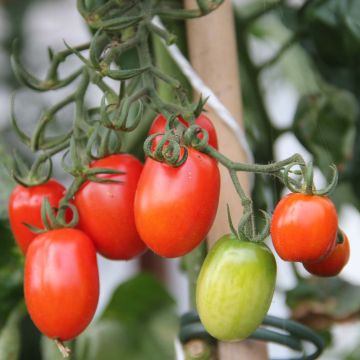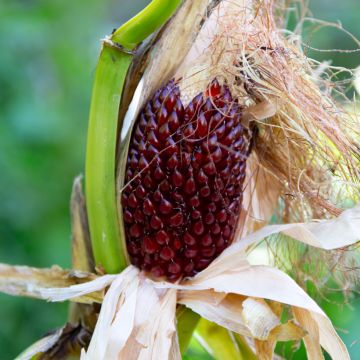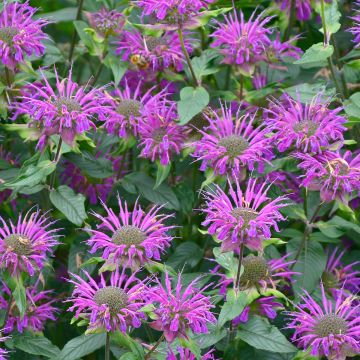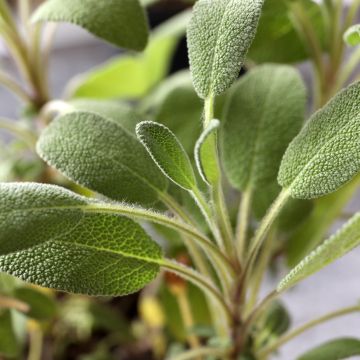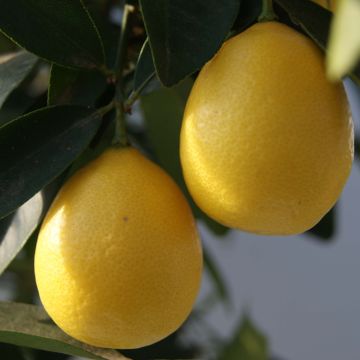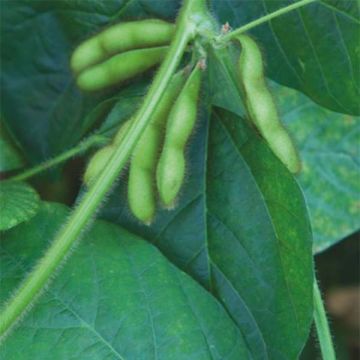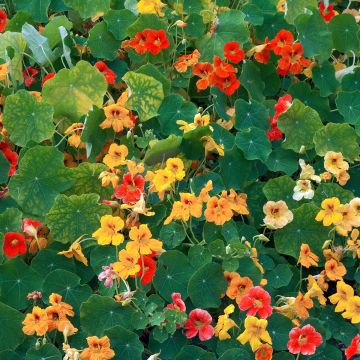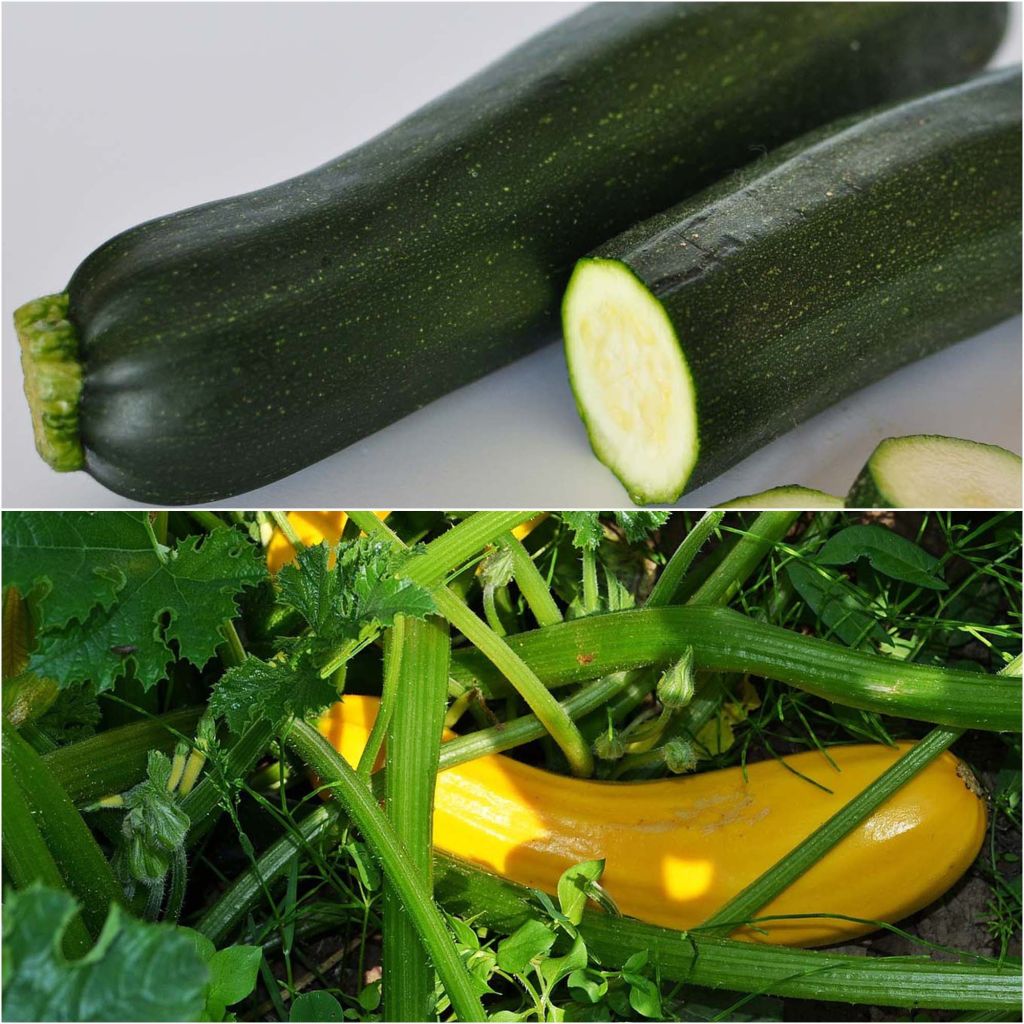

Collection of Two Courgettes - Young Grafted Plants
Collection of Two Courgettes - Young Grafted Plants
Cucurbita pepo Kimber F1 - Sebring F1
Courge d'été
This plant carries a 6 months recovery warranty
More information
We guarantee the quality of our plants for a full growing cycle, and will replace at our expense any plant that fails to recover under normal climatic and planting conditions.
From €7.90 for pickup delivery and €6.90 for home delivery
Express home delivery from €8.90.
Collection items (2 plants)
Description
Twin grafts of courgette plants: 'Kimber F1' with bright green fruits that yield abundant harvests even in difficult conditions; and 'Sebring F1' with bright yellow, long, slender, and cylindrical courgettes. Grafted plants provide additional vigor that helps courgettes establish and produce more quickly.
The ocurgette (Cucurbita pepo) belongs to the Cucurbitaceae family, like other squashes (pumpkin, patidou, butternut, acorn squash, pattypan, kabocha...). They all originate from America and were introduced to Europe in the 16th century. Easily hybridising, squashes exhibit a wide diversity of colours (orange, green, red, yellow, black, and even blue), sizes, and shapes.
The courgette is an annual plant, with an upright habit, offering beautiful yellow flowers from May to October. It is harvested when young, i.e. before complete development. The majority of varieties are non-climbing, but there are a few vine varieties that spread on the ground and require pinching. Courgettes can be round or long, usually green but sometimes yellow or white.
In cooking, courgettes are often cooked: sautéed, fried, in gratins, soups, or stuffed, and of course, they are part of the ratatouille. Courgettes can also be eaten raw, grated and mixed with other raw vegetables.
They are fruits that require regular watering. They love heat and sun and appreciate sheltered locations.
The harvest: this takes place from July to October, by cutting the fruits with pruning shears. Harvest young and tender courgettes, without letting them grow too big (on average every 2 days during peak season). Regular harvesting will promote the development of new fruits. You can also pick the male flowers (preferably in the morning), which can be eaten fried or stuffed. Male flowers, which do not produce fruits, appear on thin, long, non-swollen stems.
Storage: Courgettes can be stored for a few days at room temperature or in the lower part of the refrigerator, and they can be cut into pieces and frozen for several months.
Gardener's tip: place a slate or a tile under the fruit. It will no longer be in direct contact with the ground, thus avoiding rotting due to moisture.
Harvest
Plant habit
Foliage
Other Collections
View all →Planting and care
Courgettes should be grown in the sun, in a sheltered location. It is a fairly demanding vegetable that requires well-fertilised soil. It is advisable to add a good compost to the soil ( at a rate of 3/4 kg per m2) a few months before planting, by digging it to a depth of 5 cm (2in), after having loosened the soil, as with any vegetable crop. The courgette thrives in cool and light soils.
Planting:
First, let the plug plants grow by transplanting them into trays or pots with a diameter of 8 to 13 cm (3 to 5in), filled with potting compost. Place them in a warm and bright place. Water regularly.
Planting in open ground is done from mid-May to mid-July, when the risk of frost is gone and the soil is sufficiently warmed up. Space the plants 80 cm (32in) apart in all directions. Soak the plants in water for a few moments before planting. Dig a hole 20 cm (8in) in all directions and place fresh organic matter at the bottom. Place the plant, cover with fine soil and tamp down. Water generously.
Maintenance:
Hoe and weed at the beginning of the cultivation. We recommend mulching the soil towards the end of June with thin successive layers of clippings, if possible mixed with dead leaves. This protection, which keeps the soil moist, also reduces weed growth. During cultivation, water regularly and generously (once a week in summer if there is mulching).
The courgette can be susceptible to powdery mildew: a white coating appears on the foliage. It is necessary to remove heavily affected leaves and, if necessary, treat with chemicals every two weeks. In the case of minor infestation, you can also treat the stems with skimmed milk, diluted at 10 to 20% in rainwater. As a preventive measure, avoid watering the foliage.
Finally, you can protect young plants from slugs and snails by placing ash or coffee grounds nearby, to be renewed when it rains.
Trailing varieties need to be pinched. When the plant has 4 or 5 leaves, cut the stem above the first two leaves. Then cut the secondary stems again, after 3 or 4 fruits have formed.
Cultivation
Care
Intended location
Similar products
Haven't found what you were looking for?
Hardiness is the lowest winter temperature a plant can endure without suffering serious damage or even dying. However, hardiness is affected by location (a sheltered area, such as a patio), protection (winter cover) and soil type (hardiness is improved by well-drained soil).

Photo Sharing Terms & Conditions
In order to encourage gardeners to interact and share their experiences, Promesse de fleurs offers various media enabling content to be uploaded onto its Site - in particular via the ‘Photo sharing’ module.
The User agrees to refrain from:
- Posting any content that is illegal, prejudicial, insulting, racist, inciteful to hatred, revisionist, contrary to public decency, that infringes on privacy or on the privacy rights of third parties, in particular the publicity rights of persons and goods, intellectual property rights, or the right to privacy.
- Submitting content on behalf of a third party;
- Impersonate the identity of a third party and/or publish any personal information about a third party;
In general, the User undertakes to refrain from any unethical behaviour.
All Content (in particular text, comments, files, images, photos, videos, creative works, etc.), which may be subject to property or intellectual property rights, image or other private rights, shall remain the property of the User, subject to the limited rights granted by the terms of the licence granted by Promesse de fleurs as stated below. Users are at liberty to publish or not to publish such Content on the Site, notably via the ‘Photo Sharing’ facility, and accept that this Content shall be made public and freely accessible, notably on the Internet.
Users further acknowledge, undertake to have ,and guarantee that they hold all necessary rights and permissions to publish such material on the Site, in particular with regard to the legislation in force pertaining to any privacy, property, intellectual property, image, or contractual rights, or rights of any other nature. By publishing such Content on the Site, Users acknowledge accepting full liability as publishers of the Content within the meaning of the law, and grant Promesse de fleurs, free of charge, an inclusive, worldwide licence for the said Content for the entire duration of its publication, including all reproduction, representation, up/downloading, displaying, performing, transmission, and storage rights.
Users also grant permission for their name to be linked to the Content and accept that this link may not always be made available.
By engaging in posting material, Users consent to their Content becoming automatically accessible on the Internet, in particular on other sites and/or blogs and/or web pages of the Promesse de fleurs site, including in particular social pages and the Promesse de fleurs catalogue.
Users may secure the removal of entrusted content free of charge by issuing a simple request via our contact form.

































